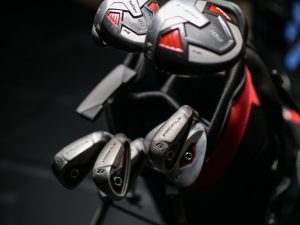The final element of how to hold a golf club that we’ll look at is the alignment of the handle in your hands. There are basically two different options – in your fingers or in your fingers and palm.
If you’ve read part 1 and part 2 of our grip series you should have selected a hand to hand relationship and grip type. Now, it’s time to make some final adjustments. Remember, the goal of a golf grip is to create consistency in both direction and distance of your golf shot. In order to be consistent you have to replicate every aspect of your golf grip from one shot to the next (easier said than done)
The world is in the palm – or fingers – of your hand
So which is better, in your fingers or in your palm? This question is most often framed in terms of feel and/or wrist freedom. Most online articles suggest that placing the club in the fingers provides advantages in both. The thinking is that fingers have many more nerve endings than does the palm so a player will be able to ‘feel’ the club with the primary connection between the club and the hand being the fingers.
As to wrist freedom, the idea is that holding the club in the fingers, further from the wrist, allows for greater wrist mobility and, consequently, more power.
I’ll not argue with the experts about either of those claims being true, but I think that the argument between holding in the fingers versus the fingers and palm may be more of a theoretical than practical argument.

For me, the question of fingers or fingers and palm is really just a question of shaft angle both at address and at impact. The current preference to hold the club in the fingers is accompanied by a preference to hanging the arms straight down from the shoulders at address. This puts the hands at their closest point to the ground assuming constant posture. Obviously, hands being closer to the ground means a flatter shaft angle.
This flatter shaft angle can only be accommodated by a similar angle in the hand. For this flatter shaft angle, if you start with the middle pad of the leading hand forefinger, the butt-end of the club handle will have to be at or near the bottom pad of the pinky finger assuming normal arm-length and no significant ulnar or radial deviation. That’s the reality of the geometry of the hand and shaft angle with the arms in this position.
Conversely, if you angle the arms away from the body and toward the ball your hands will be higher off the ground and your shaft angle will be steeper. This means that the angle of the golf handle in your hand will have to change, pushing the butt-end into your palm, or ulnar deviation will have to increase. You simply cannot keep the club in your fingers with a steeper shaft angle unless you increase ulnar deviation. The steeper the shaft angle, the deeper into your palm the butt-end will move or the more you must deviate your wrist.
So the real question is what is the best shaft angle and consequently the proper golf grip? The answer is, of course, it depends on the person. Players have proven successful with both flatter and steeper shaft angles and, consequently, with both finger and finger and palm grips.
The low hands and finger grip is presently the most popular among the pros so it can’t be all wrong. For some, they feel that hanging their arms is a way to monitor and combat undesired tension in their shoulders. If you find you have trouble relaxing at address, hanging your arms straight down may help you control that.
This position may also make it easier for you to have more consistency in your setup at address. Hanging your arms straight down is the easiest position to find in part because gravity helps you find it. If you find yourself second-guessing your distance from the ball, low hands and a finger grip with the associated easy arm position of straight down might be helpful.
However, there are some reasons to consider higher hands and a finger and palm golf grip. The most obvious is making the position at address more similar to the position at contact.
While most current pros start with low hands, none contact the ball that way. They start with their arms at 90 degrees to the ground and a significantly flatter shaft angle. During their swing, they reduce the angle of their arms and increase the angle of the shaft, requiring them to ‘stand up’ in order to preserve the necessary distance from the ball.
The alternative to this is to address the ball with less arm angle and more shaft angle. An extreme version of this is the ‘single plane’ swing often attributed to Moe Norman and currently used by Bryson DeChambeau.
The idea in either is to have the hand and arm position at address be more similar to the hand and arm position at impact. For those struggling with the myriad moving parts of the golf swing, this change may prove useful. One unavoidable consequence of raising the hands is that the butt-end must move into the palm or ulnar deviation must increase.
Some may argue that the club must be in the fingers so the hands must be positioned where necessary to facilitate that. I find no justification for such a dogmatic position as I have seen no compelling argument of biomechanical advantage. In fact, the higher hand position at impact invariably requires either some movement of the butt-end to the palm or significant ulnar deviation that may be impossible or potentially injurious for many players.
As is the case with all of the other aspects of a proper golf grip, this really comes from personal preference, commitment to that preference, and practice. Anything from maximally low hands and finger grip to a single-plane setup and resulting finger and palm grip can work. The key is, as has consistently been the case, practice, practice, practice.
Regardless of what you decide, anchoring the left-hand golf grip in the middle pad of the forefinger is a consistent recommendation. Sliding the radial (forefinger) end of the shaft into the palm has no recommendation in anything that I have seen or read. I can’t even hold and swing the club that way as the necessary palmar flexion to do so is just too uncomfortable even before trying to cock my wrist. I’m not sure how many people try to hold the club this way, but if you do, try moving it to the middle pad of your left forefinger and take it from there.
The correct golf grip – concluding thoughts
Start talking with people about golf grips and you’re going to find some really strong opinions. My rule of thumb with golf advice is to immediately discount the opinions of anyone that suggests there is only one correct golf swing.
I love the insights of those that evaluate elements of a golf swing in light of the laws of physics and biomechanics. Often these help inform us as to why we are struggling with some element of our grip or swing. However, the incredibly wide range of grips and swings that pros use tells us that there is an important difference between the theoretical and the practical in golf.
After all, if Dustin Johnson and Bryson DeChambeau can both crush the ball and win major championships with wildly different grips and swings, we shouldn’t expect that there is only one correct golf grip. The secret is committing to practice enough that you can test different elements of and changes to your golf grip and take advantage of those that work.
In the end, the question is not what is the best golf grip for everyone else but what is the best golf grip for you now and for where you’re trying to take your golf game. Best of luck in that journey. Now get out there and start attacking the pin!
We’d love to hear from you. Please share your thoughts and what you’ve learned about what works for you and what doesn’t.






